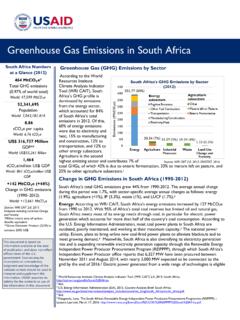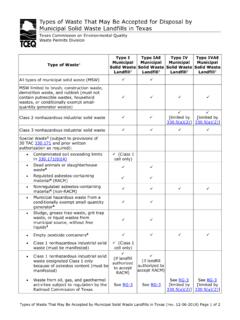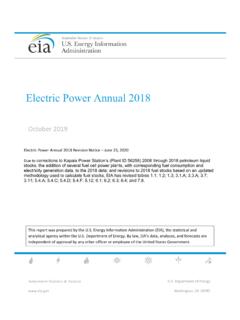Transcription of United States Agency Landfill Gas Emissions Model …
1 United States Environmental Protection EPA-600/R-05/047. Agency May 2005. Landfill Gas Emissions Model ( landgem ) Version User's Guide EPA-600/R-05/047. May 2005. Landfill Gas Emissions Model ( landgem ) Version User's Guide by Amy Alexander, Clint Burklin, and Amanda Singleton Eastern Research Group Morrisville, NC. Purchase Order No. 3C-R127-NALX. Project Officer: Susan A. Thorneloe Office of Research and Development National Risk Management Research Laboratory Air Pollution Prevention and Control Division Research Triangle Park, NC 27711. Environmental Protection Agency Office of Research and Development Washington, DC 20460. Abstract The Landfill Gas Emissions Model ( landgem ) is an automated estimation tool with a Microsoft Excel interface that can be used to estimate emission rates for total Landfill gas, methane, carbon dioxide, nonmethane organic compounds, and individual air pollutants from municipal solid waste landfills.
2 This guide provides step-by-step guidance for using this software application, as well as an appendix containing background information on the technical basis of landgem . landgem can use either site-specific data to estimate Emissions or default parameters if no site-specific data are available. The Model contains two sets of default parameters, CAA defaults and inventory defaults. The CAA defaults are based on federal regulations for MSW landfills laid out by the Clean Air Act (CAA) and can be used for determining whether a Landfill is subject to the control requirements of these regulations. The inventory defaults are based on emission factors in EPA's Compilation of Air Pollutant Emission Factors (AP-42) and can be used to generate emission estimates for use in emission inventories and air permits in the absence of site-specific test data.
3 Ii Foreword The Environmental Protection Agency (EPA) is charged by Congress with protecting the Nation's land, air, and water resources. Under a mandate of national environmental laws, the Agency strives to formulate and implement actions leading to a compatible balance between human activities and the ability of natural systems to support and nurture life. To meet this mandate, EPA's research program is providing data and technical support for solving environmental problems today and building a science knowledge base necessary to manage our ecological resources wisely, understand how pollutants affect our health, and prevent or reduce environmental risks in the future. The National Risk Management Research Laboratory (NRMRL) is the Agency 's center for investigation of technological and management approaches for preventing and reducing risks from pollution that threaten human health and the environment.
4 The focus of the Laboratory's research program is on methods and their cost-effectiveness for prevention and control of pollution to air, land, water, and subsurface resources; protection of water quality in public water systems; remediation of contaminated sites, sediments and ground water; prevention and control of indoor air pollution; and restoration of ecosystems. NRMRL collaborates with both public and private sector partners to foster technologies that reduce the cost of compliance and to anticipate emerging problems. NRMRL's research provides solutions to environmental problems by: developing and promoting technologies that protect and improve the environment; advancing scientific and engineering information to support regulatory and policy decisions; and providing the technical support and information transfer to ensure implementation of environmental regulations and strategies at the national, state, and community levels.
5 This publication has been produced as part of the Laboratory's strategic long-term research plan. It is published and made available by EPA's Office of Research and Development to assist the user community and to link researchers with their clients. Sally Gutierrez, Acting Director National Risk Management Research Laboratory iii EPA Review Notice This report has been peer and administratively reviewed by the Environmental Protection Agency and approved for publication. Mention of trade names or commercial products does not constitute endorsement or recommendation for use. This document is available to the public through the National Technical Information Service, Springfield, Virginia 22161. iv Table of Contents Section Page Abstract .. ii List of Images .. vi List of Tables .. vi Introduction .. 1. Overview of How landgem Works .. 1. 1. Understanding landgem .
6 3. Spreadsheet Design .. 3. First-Order Decomposition Rate Equation .. 4. Software Requirements .. 5. Significant Differences Between Model Versions .. 6. Differences Between the Model and AP-42 .. 7. 2. Providing Landfill Characteristics .. 9. Landfill Name or Identifier .. 9. Landfill Open Year .. 10. Landfill Closure Year .. 10. Have Model Calculate Closure Year? .. 11. Waste Design Capacity .. 12. Landfills Accepting Waste Over 80 Years .. 12. 3. Determining Modeling Parameters .. 15. Methane Generation Rate (k) .. 16. Potential Methane Generation Capacity (Lo) .. 17. Nonmethane Organic Compound Concentration .. 17. Methane Content .. 17. 4. Selecting Gases/Pollutants .. 19. 5. Entering Waste Acceptance Data .. 23. 6. Printing Inputs .. 27. 7. Viewing and Printing Tabular Results .. 29. 8. Viewing and Printing Graphical Results .. 31.
7 9. Viewing and Printing Inventory Results .. 33. 10. Viewing and Printing the Summary Report .. 35. 11. Additional Information and References .. 37. Appendix A Technical Background .. 41. v List of Images Image Page 1. Macro Security Warning Message .. 5. 2. Landfill Characteristics Inputs .. 9. 3. Model Parameters Inputs .. 15. 4. Gas/Pollutant Inputs .. 21. 5. Waste Acceptance Rate Inputs .. 23. 6. INPUT REVIEW Worksheet .. 27. 7. RESULTS Worksheet .. 29. 8. Graphical Results in Units of Megagrams per Year .. 31. 9 INVENTORY Worksheet .. 33. List of Tables Table Page 1. Worksheet Names and Functions in landgem .. 4. 2. Values for the Methane Generation Rate (k) .. 16. 3. Values for the Potential Methane Generation Capacity (Lo) .. 17. 4. Gas/Pollutant Default Data Used in landgem .. 19. 5. Acceptance Rate Input Options .. 24. vi Introduction This document provides step-by-step guidance for using the Landfill Gas Emissions Model ( landgem ), a software application with a Microsoft Excel interface that estimates air pollutants and other gases from municipal solid waste (MSW) landfills.
8 Using this document, you will learn how to Enter Landfill -specific data, Choose between site-specific and default Model parameters, Estimate emission rates, and View and print tabular and graphical results. Overview of How landgem Works landgem is an automated tool for estimating emission rates for total Landfill gas, methane, carbon dioxide, nonmethane organic compounds (NMOCs), and individual air pollutants from MSW landfills. Landfill owners and operators can use landgem to determine if a Landfill is subject to the control requirements of the federal New Source Performance Standards (NSPS) for new MSW landfills (40 CFR 60 Subpart WWW), the federal Emission Guidelines (EG) for existing MSW landfills (40 CFR Subpart Cc), or the National Emission Standards for Hazardous Air Pollutants (NESHAP) for MSW landfills (40 CFR Subpart AAAA). landgem can use either site-specific data to estimate Emissions or default parameters if no site-specific data are available.
9 landgem contains two sets of default parameters. CAA Defaults The CAA defaults are based on requirements for MSW landfills laid out by the Clean Air Act (CAA), including the NSPS/EG and NESHAP. This set of default parameters yields conservative emission estimates and can be used for determining whether a Landfill is subject to the control requirements of the NSPS/EG. or NESHAP. Inventory Defaults With the exception of wet Landfill defaults, the inventory defaults are based on emission factors in the Environmental Protection 1. Agency 's (EPA's) Compilation of Air Pollutant Emission Factors (AP-42). This set of defaults yields average Emissions and can be used to generate emission estimates for use in emission inventories and air permits in the absence of site-specific test data. The default parameters in Version of landgem represent values specified by NSPS/EG and NESHAP for determining applicability of CAA requirements.
10 Also included are values specified in AP-42 for developing national and state emission inventories. The AP-42 values are being updated with new information that has been collected by EPA from more recent field tests. In addition, research is underway to obtain data for developing emission factors for wet/bioreactor landfills where leachate and other liquids are added to accelerate waste decomposition. 2. Section 1. Understanding landgem . landgem is based on a first-order decomposition rate equation for quantifying Emissions from the decomposition of landfilled waste in MSW landfills. The software provides a relatively simple approach to estimating Landfill gas Emissions . Model defaults are based on empirical data from landfills. Field test data can also be used in place of Model defaults when available. Further guidance on EPA test methods, CAA regulations, and other guidance regarding Landfill gas Emissions and control technology requirements can be found at landgem is considered a screening tool the better the input data, the better the estimates.
















